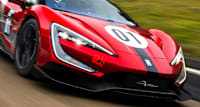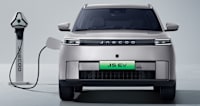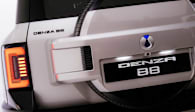In his 15 years at BMW, the Munich car maker's US-born head of design has overseen the creation of some of the industry's most admired and imitated, if controversial, cars.
During that time, BMW has become the world's top premium car brand, selling 1.4 million units a year; more than Mercedes, Lexus or Audi.
Bangle's name is most often associated with “flame surfacing,” the distinctive convex/concave styling on the sides of the car maker's 1 Series, 3 Series and Z4 sports cars, that brought eye-catching curves to a hitherto neglected part of the car.
But car buffs are split between those who love the design language developed on his watch, and those who loathe it.
The amiable 50-year-old Midwesterner's surname has even cropped up in the phrase “Bangle-butt”, a derisive term for the rear-end styling he introduced on some of his cars.
The criticism reached a crescendo a few years ago, when BMW pushed through a big revamp of its range.
Today, Bangle says, the community of his critics is 'vocal' rather than large, but gamely acknowledges the criticism as part of the job.
“If you're going to plough snow, you're going to get some up your nose,” he says.
“It's inevitable, it's part of what being a pioneer is about.”
In an interview, Bangle is loquacious, occasionally funny and confident about the designs developed under his direction.
And if imitation is the sincerest form of flattery, his team's cars have some powerful admirers. Top-end competitors including Mercedes and Lexus have developed vehicles that seem to owe some debt to BMW.
Under Bangle's remit, which also covers BMW's Mini and Rolls-Royce brands, the group aims to make cars that “solve the problem first and become the standard”.
“What we're trying to do is maintain a forward movement of iconic vehicles so BMW and Mini remain the reference point,” Bangle says.
BMW's top-selling X5, now in its second generation, pioneered the “sports activity vehicle” segment.
With the Mini, BMW “solved the problem of the small premium hatchback”, Bangle says.
“Suddenly, everyone wants to be Mini, and we can make derivatives.”
At the recent Frankfurt Motor Show, BMW premiered the Mini Clubman estate wagon and the X6, which it described as a “sports activity coupe”.
BMW hopes the X6, a high-off-the-ground vehicle with the look of a chunky sports car, will open another new segment when it goes on sale next year.
BMW's innovations extend to interior design and Bangle can speak eloquently about such things as cup holders.
The company even speaks of a “cup-holder principle,” the small design details that can inspire disproportionately strong emotions in drivers.
There is certainly no dearth of emotions about Bangle's designs.
“He's polluted the visual landscape in which we all have to live,” says Slate blogger Mickey Kaus, a frequent Bangle critic, who describes even BMW's “better new” designs, such asthe X6, as “florid and effeminate”.
One online petition urges BMW to “fire Chris Bangle, and do not allow him to design (ruin)any more of your wonderful BMWs.”
Bangle's admirers say the invective against him is the price of being an innovator.
“He defied convention,” says Detroit-based AutoWeek magazine's editor, Dutch Mandel.
“He looked at what was going on and pushed beyond people's comfort levels.”
Asked whether the criticism; most of it online and centred in the US, BMW's biggest market bothered him, but Bangle talks about the “Italian car-accident phenomenon,” based on a serious accident he had in Italy many years ago.
“Instantly out of the crowd around you come dozens and dozens of people who have an opinion about it,” he says.
Anyone who gained notoriety in the current communications culture, he says, is subjected to “equal measures of condemnation or canonisation”.
However, analysts who follow BMW say the attention paid to the American design chief, positive or otherwise, is not misplaced.
In a briskly competitive global business that produces few truly bad-quality vehicles these days, design is a crucial differentiator.
BMW is selling record numbers, as Bangle points out, and every new generation of its cars has outsold its predecessor.
However, BMW's share price performance and return on sales are lagging behind those of Mercedes; resurgent after DaimlerChrysler's sale of Chrysler and Audi, which is expanding worldwide rapidly.
BMW's controlling shareholder, the Quandt family, is keen to lift performance at the car maker, whose managers are due to report on an ongoing strategic review next month.
“You get the sense that BMW has overdone it, they've challenged the customer base too much,” Credit Suisse auto research head Arndt Ellinghorst says.
A BMW spokesman points to customer research showing that exterior design remains the second most important purchase reason for its customers, after brand loyalty.
It may also be Bangle's misfortune that car design is a notoriously subjective field that lends itself to constant second-guessing.
“It's like soccer: everyone knows better than the actual coach,” one colleague says.
Colleagues also describe him as a skillful manager of a surprisingly gruelling and unglamorous professional process, which requires the ability to juggle delicate relationships with both board-member bosses and design team members.
In the old days, companies such as General Motors parcelled out the design of a car's bumper or headlights to individual team members.
Today, designers at BMW compete on separate teams and can spend years on a prototype only to see it rejected.
“You go into a serious funk when that happens,” he says.
Bangle has personal experience of this.
During his first three years at Fiat, where he worked from 1985 until 1991, all of his designs were rejected.
Changing was about becoming “more committed to the truth of the design”, he says.
“Once we changed our philosophy and said we would put design first, we won practically every project.”
He designed a heralded coupe for Fiat.
Though there were few BMW cars in Wisconsin when Bangle was growing up in the 1970s, he does remember the brand's upscale motorcycles, driven by besuited businessmen rather than stereotypical leather-jacketed toughs.
“BMW seemed like something intellectually on a different plane,” he says.
He studied design in Pasadena before moving to Europe to work at Opel, Fiat, and from 1992 BMW. He is married to a Swiss woman, and his son was born in Turin.
In 2005, BMW's brand got its own chief designer, Dutchman Adrian van Hooydonk, who answers to Bangle as the group's head of design.
Critics, including Kaus, say this amounted to a “kick upstairs.” The company says the changes reflect a fast-expanding business.
By all accounts, the design chief still has his hands full.
“This is not a glamorous job,” he says. “It's very much a hammers-and-tongs daily job.”







.jpg)




.jpg)

.jpg)


.jpg)







